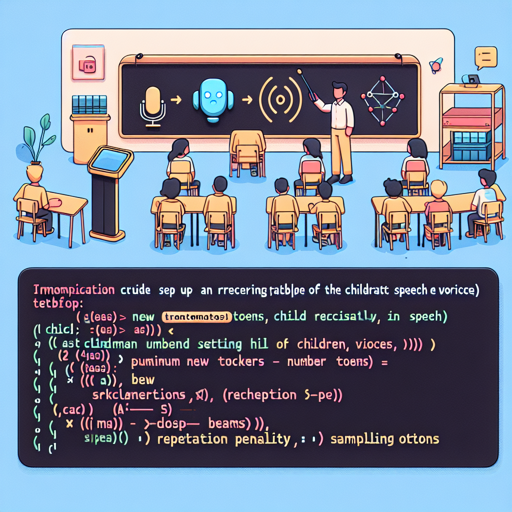Automatic Speech Recognition (ASR) has revolutionized how we interact with technology through voice commands and transcription services. In this guide, we’ll explore how to set up an ASR model using the Transformers library, specifically tuned for child speech in classroom settings. We’ll break down the steps necessary to prepare and run your ASR pipeline effectively.
Setting Up Your ASR Pipeline
To get started with your ASR implementation, you’ll need to prepare your pipeline. Below is a simple snippet of code that should help you out:
asr_model = prepare_pipeline(
model_dir='.', # wherever you save the model
generate_kwargs={
'max_new_tokens': 112,
'num_beams': 1,
'repetition_penalty': 1,
'do_sample': False
}
)Here’s a closer look at the components of this code:
- model_dir: Specify the directory where your ASR model is saved.
- generate_kwargs: This parameter includes various options for generating text from audio. Notably:
- max_new_tokens: Limits output to 112 tokens.
- num_beams: Controls the number of beams for beam search (set to 1 for greedy decoding).
- repetition_penalty: Helps prevent repetition in generated text.
- do_sample: If set to False, generates text deterministically.
Running the ASR Model
Once your model is prepared, you can run ASR on a specific audio file with the following command:
asr_model(audio_path)To process a full directory of audio files, you can use:
ASRdirWhisat(
audio_dir,
out_dir='..whisat_results',
model_dir='.'
)This command will take all files from the specified audio_dir, apply your ASR model, and output results to out_dir.
Training Your Model
If you’re interested in retraining the ASR model for optimal performance, you can do so using the training script provided:
tune_hf_whisper.pyYou’ll also need to ensure you have the right training parameters by referencing the hparams.yaml file and your training data manifest. Note that to recreate the training, you will need to acquire the public datasets:
- MyST (myst-v0.4.2)
- CuKids
- CSLU
Ensure these datasets are stored at paths that are consistent with those mentioned in your data manifest file, PUBLIC_KIDS_TRAIN_v4_deduped.csv.
Troubleshooting Tips
While implementing ASR with the Transformers library, you might encounter several issues. Here are solutions to some common problems:
- Model not found: Double-check that model_dir is correctly set to the directory where your model is located.
- Audio format errors: Ensure your audio files are in a compatible format (e.g., WAV or MP3) and not excessively noisy.
- Output discrepancies: If your output seems off, consider adjusting the generate_kwargs parameters, especially max_new_tokens and num_beams.
- Training process fails: Verify that you have all necessary datasets and that their paths align with your manifest file.
For more insights, updates, or to collaborate on AI development projects, stay connected with fxis.ai.
Conclusion
Implementing ASR systems can seem daunting, but with the right preparation and understanding, it becomes a manageable task. As you work through the setup and troubleshooting processes, keep in mind the importance of ensuring your datasets and configurations are correctly aligned for optimal model performance.
At fxis.ai, we believe that such advancements are crucial for the future of AI, as they enable more comprehensive and effective solutions. Our team is continually exploring new methodologies to push the envelope in artificial intelligence, ensuring that our clients benefit from the latest technological innovations.

